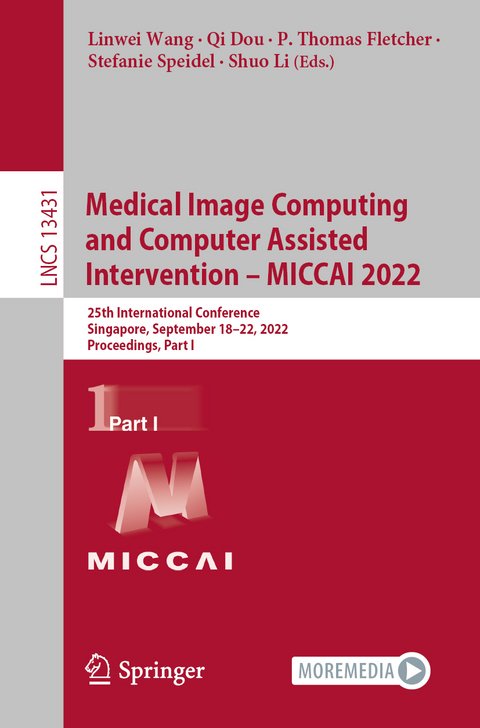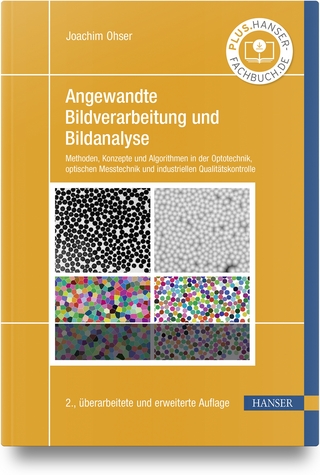
Medical Image Computing and Computer Assisted Intervention – MICCAI 2022
Springer International Publishing (Verlag)
978-3-031-16430-9 (ISBN)
The eight-volume set LNCS 13431, 13432, 13433, 13434, 13435, 13436, 13437, and 13438 constitutes the refereed proceedings of the 25th International Conference on Medical Image Computing and Computer-Assisted Intervention, MICCAI 2022, which was held in Singapore in September 2022.
The 574 revised full papers presented were carefully reviewed and selected from 1831 submissions in a double-blind review process. The papers are organized in the following topical sections:Part I: Brain development and atlases; DWI and tractography; functional brain networks; neuroimaging; heart and lung imaging; dermatology;
Part II: Computational (integrative) pathology; computational anatomy and physiology; ophthalmology; fetal imaging;
Part III: Breast imaging; colonoscopy; computer aided diagnosis;
Part IV: Microscopic image analysis; positron emission tomography; ultrasound imaging; video data analysis; image segmentation I;
Part V: Image segmentation II; integration of imaging with non-imaging biomarkers;
Part VI: Image registration; image reconstruction;
Part VII: Image-Guided interventions and surgery; outcome and disease prediction; surgical data science; surgical planning and simulation; machine learning - domain adaptation and generalization;
Part VIII: Machine learning - weakly-supervised learning; machine learning - model interpretation; machine learning - uncertainty; machine learning theory and methodologies.
Brain Development and Atlases.- Progression models for imaging data with Longitudinal Variational Auto Encoders.- Boundary-Enhanced Self-Supervised Learning for Brain Structure Segmentation.- Domain-Prior-Induced Structural MRI Adaptation for Clinical Progression Prediction of Subjective Cognitive Decline.- 3D Global Fourier Network for Alzheimer's Disease Diagnosis using Structural MRI.- CASHformer: Cognition Aware SHape Transformer for Longitudinal Analysis.- Interpretable differential diagnosis for Alzheimer's disease and Frontotemporal dementia.- Is a PET all you need? A multi-modal study for Alzheimer's disease using 3D CNNs.- Unsupervised Representation Learning of Cingulate Cortical Folding Patterns.- Feature robustness and sex differences in medical imaging: a case study in MRI-based Alzheimer's disease detection.- Extended Electrophysiological Source Imaging with Spatial Graph Filters.- DWI and Tractography.- Hybrid Graph Transformer for Tissue Microstructure Estimation with Undersampled Diffusion MRI Data.- Atlas-powered deep learning (ADL) - application to diffusion weighted MRI.- One-Shot Segmentation of Novel White Matter Tracts via Extensive Data Augmentation.- Accurate Corresponding Fiber Tract Segmentation via FiberGeoMap Learner.- An adaptive network with extragradient for diffusion MRI-based microstructure estimation.- Shape-based features of white matter fiber-tracts associated with outcome in Major Depression Disorder.- White Matter Tracts are Point Clouds: Neuropsychological Score Prediction and Critical Region Localization via Geometric Deep Learning.- Segmentation of Whole-brain Tractography: A Deep Learning Algorithm Based on 3D Raw Curve Points.- TractoFormer: A Novel Fiber-level Whole Brain Tractography Analysis Framework Using Spectral Embedding and Vision Transformers.- Multi-site Normative Modeling of Diffusion Tensor Imaging Metrics Using Hierarchical Bayesian Regression.- Functional Brain Networks.- Contrastive Functional Connectivity Graph Learning for Population-based fMRI Classification.- Joint Graph Convolution for Analyzing Brain Structural and Functional Connectome.- Decoding Task Sub-type States with Group Deep Bidirectional Recurrent Neural Network.- Hierarchical Brain Networks Decomposition via Prior Knowledge Guided Deep Belief Network.- Interpretable signature of consciousness in resting-state functional network brain activity.- Nonlinear Conditional Time-varying Granger Causality of Task fMRI via Deep Stacking Networks and Adaptive Convolutional Kernels.- fMRI Neurofeedback Learning Patterns are Predictive of Personal and Clinical Traits.- Multi-head Attention-based Masked Sequence Model for Mapping Functional Brain Networks.- Dual-HINet: Dual Hierarchical Integration Network of Multigraphs for Connectional Brain Template Learning.- RefineNet: An Automated Framework to Generate Task and Subject-Specific Brain Parcellations for Resting-State fMRI Analysis.- Modelling Cycles in Brain Networks with the Hodge Laplacian.- Predicting Spatio-Temporal Human Brain Response Using fMRI.- Revealing Continuous Brain Dynamical Organization with Multimodal Graph Transformer.- Explainable Contrastive Multiview Graph Representation of Brain, Mind, and Behavior.- Embedding Human Brain Function via Transformer.- How Much to Aggregate: Learning Adaptive Node-wise Scales on Graphs for Brain Networks.- Combining multiple atlases to estimate data-driven mappings between functional connectomes using optimal transport.- The Semi-constrained Network-Based Statistic (scNBS): integrating local and global information for brain network inference.- Unified Embeddings of Structural and Functional Connectome via a Function-Constrained Structural Graph Variational Auto-Encoder.- Neuroimaging.- Characterization of brain activity patterns across states of consciousness based on variational auto-encoders.- Conditional VAEs for confound removal and normative modelling of neurodegenerative diseases.- Semi-supervised learning with data harmonisation for biomarker discovery from resting state fMRI.- Cerebral Microbleeds Detection Using a 3D Feature Fused Region Proposal Network with Hard Sample Prototype Learning.- Brain-Aware Replacements for Supervised Contrastive Learning in Detection of Alzheimer's Disease.- Heart and Lung Imaging.- AANet: Artery-Aware Network for Pulmonary Embolism Detection in CTPA Images.- Siamese Encoder-based Spatial-Temporal Mixer for Growth Trend Prediction of Lung Nodules on CT Scans.- What Makes for Automatic Reconstruction of Pulmonary Segments.- CFDA: Collaborative Feature Disentanglement and Augmentation for Pulmonary Airway Tree Modeling of COVID-19 CTs.- Decoupling Predictions in Distributed Learning for Multi-Center Left Atrial MRI Segmentation.- Scribble-Supervised Medical Image Segmentation via Dual-Branch Network and Dynamically Mixed Pseudo Labels Supervision.- Diffusion Deformable Model for 4D Temporal Medical Image Generation.- SAPJNet: Sequence-Adaptive Prototype-Joint Network for Small Sample Multi-Sequence MRI Diagnosis.- Evolutionary Multi-objective Architecture Search Framework: Application to COVID-19 3D CT Classification.- Detecting Aortic Valve Pathology from the 3-Chamber Cine Cardiac MRI View.- CheXRelNet: An Anatomy-Aware Model for Tracking Longitudinal Relationships between Chest X-Rays.- Reinforcement learning for active modality selection during diagnosis.- Ensembled Prediction of Rheumatic Heart Disease from Ungated Doppler Echocardiography Acquired in Low-Resource Settings.- Attention mechanisms for physiological signal deep learning: which attention should we take?.- Computer-aided Tuberculosis Diagnosis with Attribute Reasoning Assistance.- Multimodal Contrastive Learning for Prospective Personalized Estimation of CT Organ Dose.- RTN: Reinforced Transformer Network for Coronary CT Angiography Vessel-level Image Quality Assessment.- A Comprehensive Study of Modern Architectures and Regularization Approaches on CheXpert5000.-LSSANet: A Long Short Slice-Aware Network for Pulmonary Nodule Detection.- Consistency-based Semi-supervised Evidential Active Learning for Diagnostic Radiograph Classification.- Self-Rating Curriculum Learning for Localization and Segmentation of Tuberculosis on Chest Radiograph.- Rib Suppression in Digital Chest Tomosynthesis.- Multi-Task Lung Nodule Detection in Chest Radiographs with a Dual Head Network.- Dermatology.- Data-Driven Deep Supervision for Skin Lesion Classification.- Out-of-Distribution Detection for Long-tailed and Fine-grained Skin Lesion Images.- FairPrune: Achieving Fairness Through Pruning for Dermatological Disease Diagnosis.- Reliability-aware Contrastive Self-ensembling for Semi-supervised Medical Image Classification.
| Erscheinungsdatum | 16.09.2022 |
|---|---|
| Reihe/Serie | Lecture Notes in Computer Science |
| Zusatzinfo | XL, 768 p. 251 illus., 239 illus. in color. |
| Verlagsort | Cham |
| Sprache | englisch |
| Maße | 155 x 235 mm |
| Gewicht | 1217 g |
| Themenwelt | Informatik ► Grafik / Design ► Digitale Bildverarbeitung |
| Technik ► Elektrotechnik / Energietechnik | |
| Schlagworte | Artificial Intelligence • automatic segmentations • Bioinformatics • Computer Aided Diagnosis • computer-aided diagnostics and therapeutics • computer assisted interventions • Computer Networks • Computer systems • computer vision • Deep learning • Image Analysis • image enhancement • Image Processing • image reconstruction • Image Segmentation • Imaging Systems • learning • machine learning • Medical Images • Medical image segmentation • Network Protocols • Neural networks • Object recognition • object segmentation • pattern recognition • segmentation methods • Signal Processing |
| ISBN-10 | 3-031-16430-X / 303116430X |
| ISBN-13 | 978-3-031-16430-9 / 9783031164309 |
| Zustand | Neuware |
| Haben Sie eine Frage zum Produkt? |
aus dem Bereich


